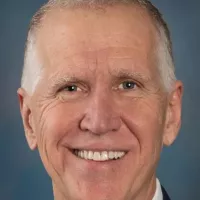Morgan Stanley is a global investment bank and financial services firm headquartered in New York City. With a substantial international presence, operating in 41 countries and employing over 90,000 individuals, it provides services to a diverse clientele including corporations, governments, institutions, and high-net-worth individuals. Recognized as one of the largest corporations in the U.S., Morgan Stanley holds significant rankings in both the Fortune 500 and Forbes Global 2000 lists, highlighting its prominent position and financial scale in the global market.
1933: Glass-Steagall Act
In 1933, the U.S. Congress passed the Glass–Steagall Act, leading to the separation of investment banking and commercial banking businesses.
September 16, 1935: Formation of the original Morgan Stanley
On September 16, 1935, the original Morgan Stanley was formed by J.P. Morgan & Co. partners Henry Sturgis Morgan, Harold Stanley, and others, in response to the Glass–Steagall Act.
1938: Distribution of debentures for United States Steel Corporation
In 1938, Morgan Stanley was involved with the distribution of US$100 million of debentures for the United States Steel Corporation as the lead underwriter.
1939: Lead syndicate in U.S. rail financing
In 1939, Morgan Stanley obtained the distinction of being the lead syndicate in the U.S. rail financing.
1941: Reorganization to allow for more activity in securities business
In 1941, Morgan Stanley went through a reorganization to allow for more activity in its securities business.
1951: Perry Hall leads Morgan Stanley
In 1951, Perry Hall became the leader of Morgan Stanley.
1952: Co-management of World Bank bonds offering
In 1952, Morgan Stanley co-managed the World Bank's triple-A-rated bonds offering.
1961: Perry Hall ends his leadership of Morgan Stanley
In 1961, Perry Hall ended his leadership of Morgan Stanley.
1962: Creation of the first viable computer model for financial analysis
In 1962, Morgan Stanley created the first viable computer model for financial analysis, marking the beginning of a new trend in the field.
1967: Establishment of Morgan & Cie, International and acquisition of Brooks, Harvey & Co., Inc.
In 1967, Morgan Stanley established Morgan & Cie, International in Paris to enter the European securities market and acquired Brooks, Harvey & Co., Inc., establishing a presence in the real estate business.
1996: Acquisition of Van Kampen American Capital
In 1996, Morgan Stanley acquired Van Kampen American Capital.
February 5, 1997: Merger with Dean Witter Discover & Co.
On February 5, 1997, Morgan Stanley merged with Dean Witter Discover & Co. Philip J. Purcell continued as chairman and CEO of the newly merged "Morgan Stanley Dean Witter Discover & Co."
1997: Merger with Dean Witter Discover & Co.
In 1997, the original Morgan Stanley merged with Dean Witter Discover & Co. Philip J. Purcell, Dean Witter's chairman and CEO, became the chairman and CEO of the newly merged "Morgan Stanley Dean Witter Discover & Co."
1998: Name change to "Morgan Stanley Dean Witter & Co."
In 1998, the name of the firm was changed to "Morgan Stanley Dean Witter & Co."
1999: Joint venture in India
In 1999, Morgan Stanley set up a joint venture in India with local partner JM Financial.
2001: September 11 attacks and employee losses
In 2001, Morgan Stanley lost 13 employees during the September 11 attacks in the World Trade Center towers. 2,687 employees were successfully evacuated.
2001: Name change back to "Morgan Stanley"
In 2001, the name was changed to "Morgan Stanley".
November 2003: Opening of the Morgan Stanley Children's Hospital
In November 2003, New York–Presbyterian Hospital named the Morgan Stanley Children's Hospital, which opened in November 2003, in recognition of Morgan Stanley's sponsorship and funding.
2003: Morgan Stanley Settles Misleading Research Suit
In 2003, Morgan Stanley settled its portion of a $1.4 billion settlement for $125 million. The suit, brought by various regulatory bodies, concerned intentionally misleading research motivated by a desire to win investment banking business.
July 2004: Morgan Stanley Fined by NASD for Late Disclosures
In July 2004, Morgan Stanley paid NASD a $2.2 million fine for more than 1,800 late disclosures of reportable information about its brokers.
September 2004: Morgan Stanley Fined by NYSE for Various Violations
In September 2004, Morgan Stanley paid a $19 million fine imposed by the NYSE for several violations, including failure to deliver prospectuses, inaccurate reporting, short sale violations, and failures in employee fingerprinting and timely filing of exchange forms.
2004: Morgan Stanley Settles Sex Discrimination Suit
In 2004, Morgan Stanley settled a sex discrimination suit brought by the Equal Employment Opportunity Commission for $54 million.
January 12, 2005: NYSE Fines Morgan Stanley for Regulatory Lapses
On January 12, 2005, the New York Stock Exchange imposed a $19 million fine on Morgan Stanley for alleged regulatory and supervisory lapses, which was the largest fine ever imposed by the NYSE at that time.
March 2005: Management crisis begins
In March 2005, Morgan Stanley experienced a management crisis that resulted in a loss of staff.
May 16, 2005: Jury Finds Morgan Stanley Failed to Give Adequate Information in Sunbeam Case
On May 16, 2005, a Florida jury determined that Morgan Stanley failed to provide Ronald Perelman with sufficient information about Sunbeam, leading to a finding of fraud and damages of $604 million. Punitive damages were added, totaling $1.450 billion. This verdict was a sanction against Morgan Stanley due to the firm's attorneys' failure to produce documents.
June 2005: Resignation of CEO Philip J. Purcell
In June 2005, Philip J. Purcell resigned as CEO of Morgan Stanley due to a public campaign by former partners.
2005: Move back to lower Manhattan
In 2005, Morgan Stanley moved 2,300 of its employees back to lower Manhattan.
March 2, 2006: Morgan Stanley Settles Class-Action Lawsuit on Unfair Labor Practices
On March 2, 2006, Morgan Stanley settled a class-action lawsuit filed in California by current and former employees in the financial advisor training program, regarding unfair labor practices. The firm reached a $42.5 million settlement without admitting fault.
December 19, 2006: Announcement of Discover Card unit spin-off
On December 19, 2006, Morgan Stanley announced the spin-off of its Discover Card unit.
February 2007: End of Indian joint venture and establishment of a wholly-owned subsidiary
In February 2007, Morgan Stanley ended its Indian joint venture, acquired its local partner's stake in the institutional brokerage business, and sold its own stake in the other businesses. The bank then set up a wholly-owned subsidiary.
March 21, 2007: Ruling Overturned in Ronald Perelman Case
On March 21, 2007, the ruling in the Ronald Perelman case was overturned, and Morgan Stanley was no longer required to pay the $1.57 billion verdict.
June 30, 2007: Completion of Discover Financial spin-off
On June 30, 2007, Morgan Stanley completed the spin-off of Discover Financial.
July 2007: Morgan Stanley Agrees to Settle Lawsuit Over Precious Metals Storage Fees
In July 2007, Morgan Stanley agreed to pay $4.4 million to settle a class-action lawsuit accusing the firm of incorrectly charging clients for storage of precious metals.
September 27, 2007: FINRA Announces Settlement with Morgan Stanley
On September 27, 2007, FINRA announced a $12.5 million settlement with Morgan Stanley, resolving charges that its former affiliate, Morgan Stanley DW, Inc. (MSDW), failed to provide emails in arbitration proceedings and to regulators.
December 19, 2007: Capital infusion from China Investment Corporation
On December 19, 2007, Morgan Stanley announced that it would receive a US$5 billion capital infusion from the China Investment Corporation in exchange for securities.
2007: Massive write-downs related to the subprime mortgage crisis
By 2007, Morgan Stanley faced massive write-downs related to the subprime mortgage crisis.
2007: Morgan Stanley Settles Class Action Lawsuit
In 2007, Morgan Stanley agreed to pay $46 million to settle a class action lawsuit brought by eight female brokers.
June 18, 2008: Morgan Stanley Admits Loss Due to Rogue Trader
On June 18, 2008, Morgan Stanley admitted that the actions of a rogue trader on one of its trading desks resulted in a $120 million loss for the firm.
August 2008: Advising the US Treasury on Fannie Mae and Freddie Mac
In August 2008, Morgan Stanley was contracted by the United States Treasury to advise the government on potential rescue strategies for Fannie Mae and Freddie Mac.
September 17, 2008: Share price slide and market turmoil
On September 17, 2008, Morgan Stanley faced difficulties after a 42% slide in its share price in two days, amidst market turmoil.
September 19, 2008: Exploration of merger possibilities
By September 19, 2008, Morgan Stanley's share price had slid 57% in four days, and the company explored merger possibilities with various financial institutions.
September 22, 2008: Conversion to traditional bank holding company
On September 22, 2008, Morgan Stanley announced it would become a traditional bank holding company regulated by the Federal Reserve.
September 29, 2008: Investment from MUFG Bank
On September 29, 2008, MUFG Bank invested $9 billion in a direct purchase of a 21% ownership stake in Morgan Stanley using a physical check.
October 14, 2008: Completion of Mitsubishi UFJ's stake in Morgan Stanley
On October 14, 2008, Mitsubishi UFJ's 21% stake in Morgan Stanley was completed, recovering the stock price.
October 2008: Stock Market Volatility
During October 2008, concerns over the completion of the Mitsubishi deal during the October 2008 stock market volatility caused a dramatic fall in Morgan Stanley's stock price.
October 2008: Risk of Failure
Within days, in October 2008, Morgan Stanley itself was at risk of failure, with rapidly changing prospects, regulatory model and ownership stakes over the course of four weeks from mid-September to mid-October 2008.
2008: Borrowing from the Fed during the crisis
During the 2008 crisis, Morgan Stanley borrowed $107.3 billion from the Fed.
2008: Losses in Process Driven Trading unit and financial crisis
In 2008, Morgan Stanley's Process Driven Trading unit experienced significant losses, contributing to the broader financial crisis.
2008: Biggest acquisition since the 2008 financial crisis
In 2008, the Morgan Stanley acquisition of E*Trade was the biggest acquisition by a U.S. bank since the 2008 financial crisis.
January 13, 2009: Global Wealth Management Group Merged with Citi's Smith Barney
On January 13, 2009, the Global Wealth Management Group was merged with Citi's Smith Barney to form Morgan Stanley Smith Barney, with Morgan Stanley owning 51% and Citi holding 49%.
March 2009: FINRA Announces Settlement with Morgan Stanley for Misconduct
In March 2009, FINRA announced that Morgan Stanley was to pay more than $7 million for misconduct in handling the accounts of 90 Rochester, New York-area retirees.
October 19, 2009: Morgan Stanley to Sell Van Kampen to Invesco
On October 19, 2009, Morgan Stanley announced it would sell Van Kampen to Invesco for $1.5 billion, while retaining the Morgan Stanley brand.
2009: Purchase of Smith Barney and formation of Morgan Stanley Smith Barney
In 2009, Morgan Stanley purchased Smith Barney from Citigroup, forming Morgan Stanley Smith Barney, a large wealth management business.
2009: Asset Management Activities
Until 2009, Morgan Stanley's asset management activities were principally conducted under the Morgan Stanley and Van Kampen brands.
April 2010: CFTC Announces Settlement with Morgan Stanley
In April 2010, the Commodity Futures Trading Commission announced that Morgan Stanley agreed to pay $14 million related to an attempt to hide prohibited trading activity in oil futures.
2010: Convertible shares for China Investment Corporation
In 2010, securities from the China Investment Corporation would be convertible to 9.9% of Morgan Stanley's shares.
August 22, 2011: Bloomberg News Service publishes Morgan Stanley's debt
On August 22, 2011, Bloomberg News Service published that Morgan Stanley borrowed $107.3 billion from the Fed during the 2008 crisis.
April 25, 2012: Garth R. Peterson Pleads Guilty to Anti-Corruption Law Violations
On April 25, 2012, Garth R. Peterson, a Morgan Stanley executive in China, pleaded guilty to violating U.S. federal anti-corruption laws for secretly acquiring property investments for himself and a Chinese government official who steered business to Morgan Stanley.
May 31, 2012: Morgan Stanley Exercised Option to Purchase Additional Stake
On May 31, 2012, Morgan Stanley exercised its option to purchase an additional 14% of the joint venture from Citi.
August 7, 2012: Morgan Stanley to Pay Fines in Price-Fixing Scandal
On August 7, 2012, it was announced that Morgan Stanley would pay $4.8 million in fines to settle a price-fixing scandal estimated to have cost New Yorkers $300 million. Morgan Stanley did not admit any wrongdoing.
June 2013: Morgan Stanley to Buy Citigroup's Stake in Smith Barney
In June 2013, Morgan Stanley announced it had secured all regulatory approvals to buy Citigroup's remaining 35% stake in Smith Barney and would finalize the deal.
September 29, 2013: Morgan Stanley Partners with Longchamp Asset Management and La Française AM
On September 29, 2013, Morgan Stanley announced a partnership with Longchamp Asset Management, a French-based asset manager specializing in UCITS hedge funds, and La Française AM, a multi-specialist asset manager with a 10-year track record in alternative investments.
November 2013: Investment in affordable housing
In November 2013, Morgan Stanley announced a $1 billion investment to improve affordable housing.
2013: Morgan Stanley v. Skowron
In 2013, in the case of Morgan Stanley v. Skowron, a U.S. District Judge held that a hedge fund employee who engaged in insider trading must repay his employer the full $31 million he was paid as compensation during his period of faithlessness, due to violating his company's code of conduct.
February 2014: Morgan Stanley to pay $1.25 billion to the US government
In February 2014, Morgan Stanley agreed to pay $1.25 billion to the US government, as a penalty for concealing the full risk associated with mortgage securities with the Federal Housing Finance Agency.
July 2014: Fundraising for Asian private equity
In July 2014, Morgan Stanley's Asian private equity arm raised around $1.7 billion for its fourth fund in the area.
September 2014: Morgan Stanley to Pay $95 Million to Resolve Lawsuit
In September 2014, Morgan Stanley agreed to pay $95 million to resolve a lawsuit by the Public Employees' Retirement System of Mississippi and the West Virginia Investment Management Board, accused of misleading investors in mortgage-backed securities.
May 2015: FINRA Fines Morgan Stanley for Reporting Violations
In May 2015, FINRA fined Morgan Stanley $2 million for short interest reporting and rule violations that occurred for more than six years.
December 2015: Reported job cuts in fixed income
In December 2015, it was reported that Morgan Stanley would be cutting around 25 percent of its fixed income jobs before month end.
January 2016: Presence in over 43 countries
In January 2016, Morgan Stanley reported that it had offices in "more than" 43 countries.
February 2016: Morgan Stanley Will Pay to Settle with Authorities
In February 2016, Morgan Stanley will pay $3.2 billion to settle with state and federal authorities over the creation of mortgage-backed bonds before the 2008 financial crisis.
August 2016: Morgan Stanley Hong Kong Securities Fined by Securities and Futures Commission
In August 2016, Morgan Stanley Hong Kong Securities Ltd. was fined HK$18.5 million ($2.4 million) by Hong Kong's securities regulator, Securities and Futures Commission, for violations of Hong Kong's Code of Conduct, including failure to avoid a conflict of interest between principal and agency trading.
December 2016: Morgan Stanley Unit Paid for Settlement
In December 2016, another unit of Morgan Stanley paid $7.5 million to settle customer protection rule violations.
January 2017: Morgan Stanley Fined for Overbilling
In January 2017, the corporation was fined $13 million due to overbilling and violating investor asset safeguarding custody rules. Morgan Stanley agreed to pay the fine without commenting on the charges.
March 2018: Morgan Stanley Acquired Mesa West
In March 2018, Morgan Stanley acquired Mesa West, a leading U.S. commercial real estate credit platform.
December 2018: FINRA Fines Morgan Stanley $10 Million for AML Failures
In December 2018, FINRA announced a $10 million fine against Morgan Stanley for failures in its anti-money laundering (AML) compliance. Morgan Stanley violated the Bank Secrecy Act over a period of five years.
2018: Broker Fired After Harassment Allegations
In 2018, Douglas E. Greenberg, a Morgan Stanley broker, was fired after allegations of harassment, threats, and assault against him surfaced from four women in Lake Oswego, Oregon. It was reported that Morgan Stanley executives were aware of these allegations, including two arrests and a federal subpoena, but did not take action. Greenberg had made the 2018 Forbes list for top wealth advisors in Oregon.
February 2019: Morgan Stanley Acquires Solium Capital
In February 2019, Morgan Stanley announced its acquisition of Solium Capital, a manager of employee stock plans, for $900 million.
April 2019: Morgan Stanley to Pay $150 Million to Settle Charges of Misleading Pension Funds
In April 2019, Morgan Stanley agreed to pay $150 million to settle charges that it had misled two large California public pension funds about the risks of mortgage-backed securities. The Attorney General commented that Morgan Stanley lied about the risk of its products, but Morgan Stanley denied wrongdoing.
November 2019: Morgan Stanley Fires Traders for Suspected Securities Mismarking
In November 2019, Morgan Stanley fired or placed on leave four traders for suspected securities mismarking. The firm suspected that $100–140 million in losses were concealed by the mismarking of the value of the securities.
February 2020: Announcement of E*Trade acquisition
In February 2020, Morgan Stanley announced its acquisition of E*Trade, a deal for $13 billion.
February 2020: Morgan Stanley Announced Acquisition of E-Trade
In February 2020, Morgan Stanley announced the acquisition of E-Trade for $13 billion.
May 2020: Morgan Stanley to Pay $5 Million Penalty for Misleading Clients
In May 2020, Morgan Stanley agreed to pay a $5 million penalty to settle allegations made by the SEC that the corporation provided misleading information to some clients in the retail wrap fee programs regarding trade-execution services and transaction costs.
October 2020: Announcement of Eaton Vance acquisition
In October 2020, Morgan Stanley announced its acquisition of Eaton Vance.
October 2020: Morgan Stanley Announces Acquisition of Eaton Vance
In October 2020, Morgan Stanley announced its agreement to acquire Eaton Vance.
October 2020: Completion of E*Trade acquisition
In October 2020, Morgan Stanley completed its acquisition of E*Trade, a deal announced in February 2020 for $13 billion.
October 2020: Morgan Stanley Completes Acquisition of E-Trade
In October 2020, Morgan Stanley completed its acquisition of E-Trade for $13 billion, marking the biggest acquisition by a U.S. bank since the 2008 financial crisis.
March 2021: Completion of Eaton Vance acquisition
In March 2021, Morgan Stanley completed its acquisition of Eaton Vance.
March 2021: Morgan Stanley Completes Acquisition of Eaton Vance
In March 2021, Morgan Stanley completed its acquisition of Eaton Vance. Following this acquisition, Morgan Stanley had $5.4 trillion of client assets across its Wealth Management and Investment Management segments.
September 2022: SEC Charges Morgan Stanley for Failing to Protect Customer Data
In September 2022, the SEC announced charges against Morgan Stanley stemming from the firm’s extensive failures, over a five-year period, to protect the personal identifying information of approximately 15 million customers. Morgan Stanley agreed to pay a $35 million penalty to settle the SEC charges.
December 2022: Layoffs conducted
In December 2022, Morgan Stanley conducted layoffs.
May 2, 2023: Morgan Stanley to cut 3,000 positions
On May 2, 2023, it was reported that Morgan Stanley planned to reduce approximately 3,000 positions by the end of June, which is about 5% of the bank's total workforce. Financial advisors and support staff were excluded from these cuts.
November 2023: Morgan Stanley Settles with Connecticut for $6.5 Million over Data Breach
In November 2023, Attorney General of Connecticut William Tong announced a $6.5 million settlement with Morgan Stanley for compromising the personal information of its customers due to negligent security practices.
2023: Expected layoffs
In 2023, Morgan Stanley expected more layoffs.
2023: Fortune 500 and Forbes Global 2000 ranking
In 2023, Morgan Stanley ranked No. 61 in the Fortune 500 list of the largest United States corporations by total revenue and ranked #30 in Forbes Global 2000.
January 2024: Morgan Stanley to Pay $249 Million to Settle Block Trade Investigation
In January 2024, Morgan Stanley agreed to pay $249 million to settle a criminal investigation and a related Security and Exchange Commission probe related to the unauthorized disclosure of block trades to investors, by the bank's supervisor for such trades and another employee.
October 2024: Morgan Stanley carbon dioxide removal purchase agreement with Climeworks
In October 2024, Morgan Stanley entered into a 40,000-tonne carbon dioxide removal purchase agreement with Climeworks, a direct air capture startup company, for an undisclosed price.
December 2024: Morgan Stanley's Ownership
As of December 2024, Morgan Stanley is primarily owned by institutional investors, holding 62.00% of the shares.
January 2025: Morgan Stanley Leaves Net-Zero Banking Alliance
In January 2025, Morgan Stanley announced its decision to leave the Net-Zero Banking Alliance, while still committing to helping the world transition to net-zero carbon emissions.
February 2025: State Attorneys General Criticize Morgan Stanley for China Investment Disclosures
In February 2025, a group of 17 U.S. state attorneys general criticized Morgan Stanley for making improper or inadequate disclosures about investments in China.
Mentioned in this timeline
The United States of America is a federal republic located...

The stock market is where buyers and sellers trade stocks...
California is the most populous US state located on the...
India officially the Republic of India is a South Asian...
Hong Kong is a densely populated special administrative region of...
Connecticut is a state located in the New England region...
Trending
16 minutes ago Mortgage Rates Drop: Affording a $440,000 Home Becomes Easier with Lower Rates.

16 minutes ago JoJo Siwa's relationship with Chris Hughes gains traction; Abby Lee Miller shares her reaction.

13 days ago Dwight Howard discusses Nike's rejection, Adidas deal, and Peak money issues.
1 hour ago Japan Earthquake Fears Rise as Manga 'Predicts' Disaster; Flights Canceled, Warnings Issued
1 hour ago Melbourne Synagogue Attacked: Netanyahu Condemns Antisemitism; Man Charged, Terror Motive Investigated.

1 hour ago Stevie Nicks Reflects on Regrets and Lindsey Buckingham's Album Refusal, a Deep Dive.
Popular

Jupiter is the fifth and largest planet from the Sun...

Candace Owens is an American conservative and far-right political commentator...

A blue moon is defined in several ways most commonly...

Thom Tillis is the senior U S Senator from North...

KPop Demon Hunters is a animated musical fantasy action comedy...

Starbucks is an American multinational coffeehouse chain established in Seattle...
